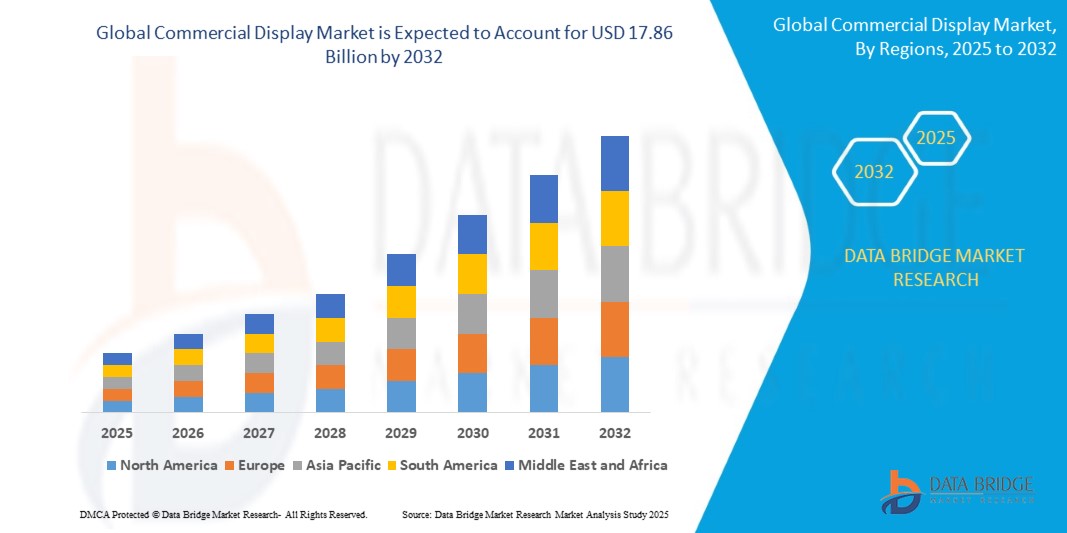
The commercial display market encompasses a wide range of electronic displays designed for use in businesses and public spaces. These displays serve diverse purposes, including digital signage, video walls, interactive touchscreens, and more.
Market Size
The global commercial display market is substantial and exhibits steady growth. Accurate market size figures can vary depending on the sources and methodologies used. However, reputable market research firms estimate the market size to be in the tens of billions of dollars, with a significant portion attributed to the Asia-Pacific region.
Global commercial display market size was valued at USD 6.91 billion in 2024 and is projected to reach USD 17.86 billion by 2032, with a CAGR of 12.60% during the forecast period of 2025 to 2032.
For more information, visit https://www.databridgemarketresearch.com/reports/global-commercial-display-market
Market Share
The market share is dynamic and influenced by several factors:
- Product Type: LCD displays continue to hold a significant market share, but LED displays, including LCD-LED backlights and OLED displays, are gaining traction due to their superior image quality and energy efficiency.
- Application: Retail, hospitality, transportation, and corporate sectors typically command the largest market shares.
- Geography: Asia-Pacific, driven by rapid economic growth and urbanization, is a major market player. North America and Europe also hold substantial market shares.
- Key Players: Leading manufacturers, such as Samsung, LG Electronics, Sharp, Panasonic, and Philips, hold significant market shares due to their extensive product portfolios, global reach, and technological advancements.
Market Opportunities
The commercial display market presents several promising opportunities:
- Digital Signage Growth: The increasing adoption of digital signage across various sectors, including retail, restaurants, and transportation, drives market demand.
- Interactive Experiences: The demand for interactive experiences, such as touchscreens and interactive kiosks, is growing rapidly in retail, hospitality, and education.
- Video Walls: The use of high-resolution video walls is increasing in control rooms, corporate lobbies, and entertainment venues.
- 4K/8K Resolution: The demand for high-resolution displays, such as 4K and 8K, is growing, particularly in applications requiring high-quality image and video content.
- Internet of Things (IoT) Integration: The integration of IoT capabilities into commercial displays, such as remote monitoring and control, is creating new market opportunities.
Market Challenges
The commercial display market also faces several challenges:
- Intense Competition: The market is characterized by intense competition among numerous players, both established and emerging.
- Price Pressure: Competitive pressures can lead to price erosion, impacting profitability.
- Technological Advancements: Rapid technological advancements necessitate continuous innovation to remain competitive and meet evolving customer demands.
- Supply Chain Disruptions: Global supply chain disruptions can impact the availability and cost of components, affecting production and delivery timelines.
- Cybersecurity Concerns: With increasing connectivity, cybersecurity concerns related to data breaches and malware attacks are becoming more critical.
Market Demand
Demand for commercial displays is driven by several factors:
- Economic Growth: Economic growth and increased consumer spending drive demand for digital signage and interactive experiences.
- Urbanization: Rapid urbanization and the growth of urban centers create demand for digital signage in public spaces and transportation hubs.
- Retail Evolution: The evolution of the retail landscape, including the rise of e-commerce and the need for engaging in-store experiences, drives demand for innovative display solutions.
- Technological Advancements: Advancements in display technologies, such as higher resolutions, improved brightness, and better energy efficiency, are driving demand for newer and more sophisticated displays.
Market Trends
Several key trends are shaping the commercial display market:
- Sustainability: Increasing focus on sustainability is driving the development of energy-efficient displays with reduced environmental impact.
- Artificial Intelligence (AI) and Machine Learning (ML): AI and ML are being increasingly used to analyze customer behavior, optimize display content, and improve the overall customer experience.
- Virtual and Augmented Reality (VR/AR): The integration of VR/AR technologies with commercial displays is creating new and immersive experiences for customers.
- Edge Computing: Edge computing is enabling faster processing and analysis of data generated by commercial displays, leading to more real-time and personalized experiences.
In conclusion, the commercial display market is a dynamic and evolving sector with significant growth potential. While challenges exist, the market is well-positioned to capitalize on emerging opportunities driven by technological advancements, changing consumer behavior, and the increasing demand for engaging and interactive experiences. The key to success lies in continuous innovation, adaptation to evolving market dynamics, and a strong focus on customer needs.

0 Comments
Post Comment